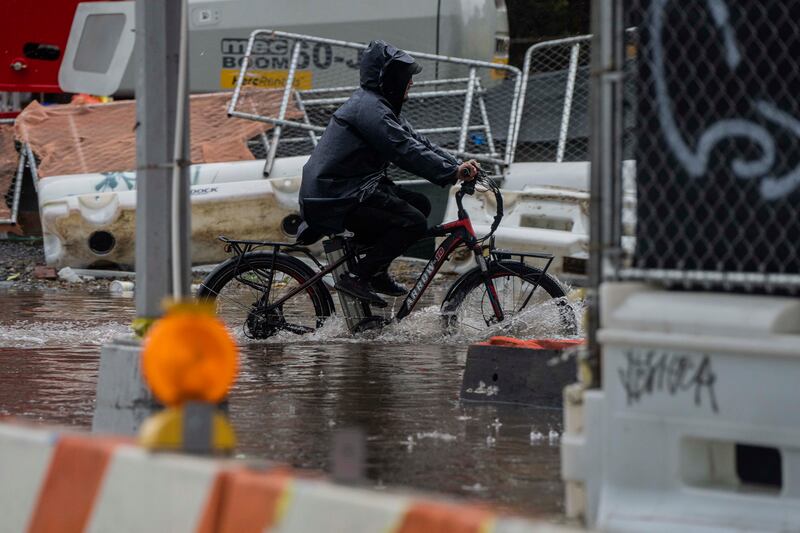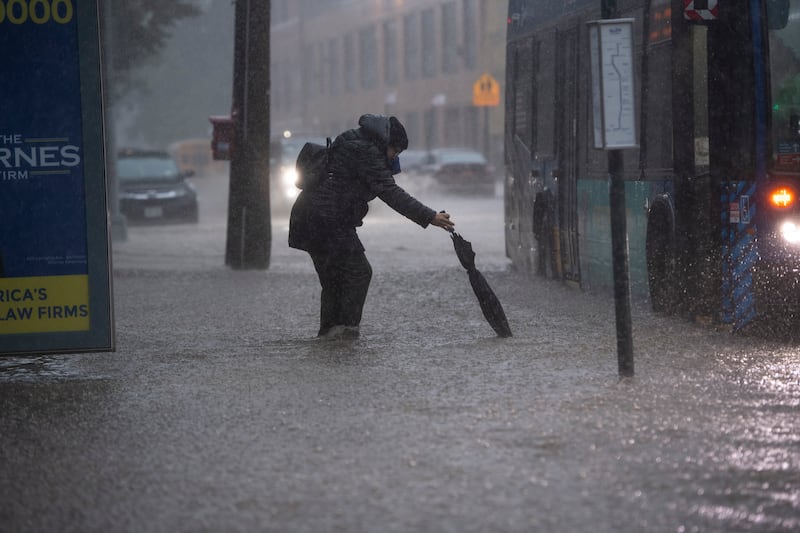Heavy rainfall pounded New York City and the surrounding region on Friday, bringing flash floods, shutting down entire subway lines, turning major roadways into lakes and sending children to the upper floors of flooding schoolhouses. Governor Kathy Hochul declared a state of emergency, urging New Yorkers to stay home and singling out those who live in basements to brace for the worst.
State and city leaders implored residents not to underestimate a storm that flipped from falling rain to fire-hose torrents in minutes. Ms Hochul called it a “life-threatening rainfall event”, and mayor Eric Adams called the storm “something that we cannot take lightly and we are not taking lightly”. The city’s residents, while largely caught by surprise, took heed and many stayed home and off the roads.
Citywide cellphone pings pushed alerts from the National Weather Service throughout the day, repeatedly extending a “considerable” flash-flood warning, a level reserved for extreme and rare rainfall events.
Cascading waterfalls shut down subway lines across much of the city, with service being halted even at major hubs. Trains were rerouted with little warning.
Russia regains influence in its ‘near abroad’ as West wraps itself in red lines
‘They just want us to work and have babies.’ Exasperation in China as Halloween falls foul of authorities
Tories shout ‘we told you so’ after Rachel Reeves’ tax-and-spend Labour budget
How Trump allies could challenge US presidential election result

Commuters turned and ventured back home on foot through scenes of chaos and upheaval.
Water gushed into brownstone basements in Park Slope, Brooklyn. In Prospect Park, the landscape was altered by new creeks. In Queens, the storm was generational, making Friday the wettest day at Kennedy International Airport since modern record-keeping began.
The sense that city leaders were largely caught off guard promised to linger after the rain had stopped falling. Mr Adams was swiftly criticised for not warning residents about the storm soon enough, and for waiting to address New Yorkers until noon on Friday.
Scenes both placid and fraught played out in the city, depending on how hard the rain was falling. Central Park became a miniature Venice, with waist-high rivers beneath its iconic arched bridges. A man in a drenched business suit leaned on a fence by the Great Lawn, and removed his boots one at a time to empty them of water.
Attention immediately turned to residents who live in flood zones, two years after the remnants of Hurricane Ida caused basement floods that killed 11 people in Queens. Many of those apartments, which are often rented to immigrants or others desperate for an affordable place to live, are not allowed to be rented legally and do not have adequate means of escape in a flood.

“Plan your escape route,” Ms Hochul said. “Don’t wait until water is over your knees before you leave. Don’t wait until it’s too late.”
Friday morning, Joy Wong plugged a pump into a wall in her house in Woodside, Queens, as her basement filled with water. Her desperation was all too familiar — three neighbours, including a toddler, had drowned in that very basement when Ida hit New York two years ago. “I’m experiencing PTSD right now,” she said.
The rain on Friday made this the second-wettest September in New York City history, according to weather service statistics: More than a foot of rain — over 14 inches — has fallen this month, the most in more than 140 years, when the city logged 16.85 inches in September 1882.

The storm created havoc for the busiest streets and highways. Many flights were cancelled or delayed at Kennedy and La Guardia.
The worst of the rain will leave Manhattan as the storm gradually heads east, said Dominic Ramunni, a weather service meteorologist. “We’ve got Manhattan on the western edge of it now, with the heaviest rain over Queens and western Nassau County,” he said. But he added, “We’re still dealing with it: we still have that fire hose of moisture coming on shore.”
In the Central Park Zoo, the storm brought about an escape: The water rose so high that a female sea lion was able to breach her pool and venture out. She did not get far, with the zoo locked down and employees watching her carefully.
Like many New Yorkers on Friday, she decided she was better off at home. – This article originally appeared in The New York Times




